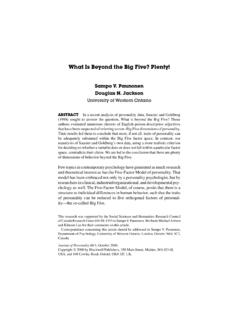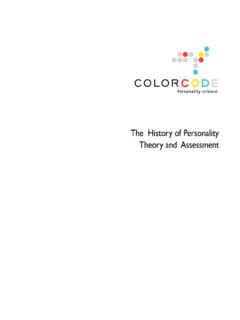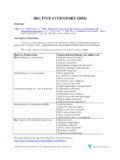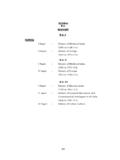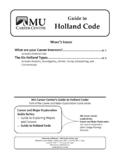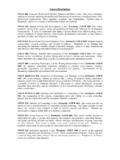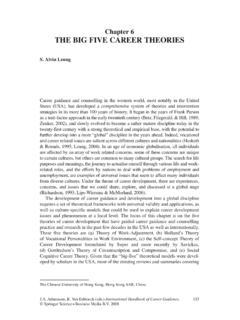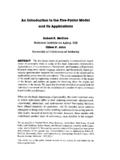Transcription of JOURNAL OF RESEARCH IN PERSONALITY 32, 498–509 (1998 ...
1 JOURNAL OF RESEARCH IN PERSONALITY32,498 509 (1998)ARTICLE between Birth Order and PERSONALITY Traits:Evidence from Self-Reports and Observer RatingsTyrone Jefferson, Jr., Jeffrey H. Herbst, and Robert R. McCraeGerontology RESEARCH Center, National Institute of Aging, National Institutes of HealthSulloway (1996) proposed that PERSONALITY traits developed in childhood mediatethe association of birth order with scientific radicalism. Birth-order effects on traitswithin the five-factor model of PERSONALITY were examined in three studies. Self-reports on brief measures of Neuroticism, Extraversion, and Openness in a nationalsample (N59664) were unrelated to birth order.
2 Self-reports on the 30 facet scalesof the Revised NEO PERSONALITY Inventory (NEO-PI-R) in an adult sample (N5612) showed only small effects for Altruism and Tender-Mindedness. Peer ratings(N5166) supported the hypotheses that laterborn children would be higher infacets of Openness and Agreeableness, but spouse ratings (N588) did not replicatethose findings. Birth order may have subtle effects on perceived PERSONALITY , but itis unlikely that this effect mediates associations with scientific s (1996)Born to Rebelprovides a fascinating synthesis of evolu-tionary theory, PERSONALITY psychology, and the history of scientific revolu-tions.
3 In brief, his argument is that, consistent with evolutionary trends inmany species, children in human families compete for parental resourcesby creating distinctive niches. Firstborn children, whose position is alreadyestablished, tend to be responsible, competitive, and conventional; laterbornchildren must distinguish themselves by being playful, cooperative, and es-pecially rebellious. As adults, those laterborns who become scientists areWe thank Frank Sulloway, Delroy Paulhus, Suzanne Phillips, and Judith Rich Harris forhelpful comments. The National Health and Nutrition Examination Survey EpidemiologicFollow-Up Study was jointly initiated by the National Institute on Aging and the NationalCenter for Health Statistics and has been developed and funded by the National Institute onAging; the National Center for Health Statistics; the National Cancer Institute; the NationalHeart, Lung, and Blood Institute; the National Institute of Arthritis, Diabetes, and Digestiveand Kidney Diseases; the National Institute of Mental Health; the National Institute of AlcoholAbuse and Alcoholism.
4 The National Institute of Allergy and Infectious Diseases; and theNational Institute of Neurological and Communicative Disorders and Jefferson, Jr., is now at Morgan State University. Correspondence and reprint re-quests should be addressed to Robert R. McCrae, Box 3, Gerontology RESEARCH Center, 5600 Nathan Shock Drive, Baltimore, MD 21224-6825. E-mail: ORDER AND PERSONALITY499attracted toward unconventional ideas and lead radical scientific revolutions,such as Darwinian evolution and some respects, Sulloway s theory fits well with contemporary knowl-edge about PERSONALITY .
5 Birth order (except perhaps for twins) is a variablethat distinguishes children in a family, and studies of the behavior geneticsof PERSONALITY (Loehlin, 1992) consistently point to the importance of suchnonshared environmental influences. Similarly, the notion that scientific in-novation is associated with PERSONALITY , especially traits in the domain ofOpenness to Experience such as unconventionality, is also plausible (Mac-Kinnon, 1962; McCrae, 1987, 1994).But in at least two other respects, Sulloway s theory appears to be incon-sistent with recent RESEARCH findings. First, it assumes that PERSONALITY charac-teristics developed in childhood1are retained into adulthood.
6 But longitudi-nal studies ( , Block, 1993; Siegler et al., 1990) show that in addition tosome continuity, there is change in rank-ordering of PERSONALITY traits be-tween early childhood and adulthood; children who are rebellious at age 4or age 11 may have become conventional by age 30. Second, and more cru-cially, influential previous reviews of birth order and PERSONALITY have re-ported little order has been a standard variable in psychological RESEARCH for de-cades, but attempts to link it to PERSONALITY traits have usually shown weakand inconsistent results. Although firstborns are usually described as beinghigher in conformity and need for achievement (Forer, 1977), these effectsmay be artifacts of differences in social class and sibship size.
7 Schooler s(1972) review concluded that few reliable effects were to be found in ade-quately controlled studies, a conclusion echoed by later reviews by Ernstand Angst (1983) and Dunn and Plomin (1990). After examining most ofthe published RESEARCH on the topic prior to 1981 over 1000 studies Ernstand Angst concluded that [birth] order does not appear to be a very stronginfluence in molding PERSONALITY in a definable way (p. 187).Hoffman s (1991) investigation of the family environment as a sourceof differences in sibling PERSONALITY may offer an explanation for the smallmagnitude of birth-order effects.
8 She noted that PERSONALITY outcomes areaffected by a multiplicity of interacting environmental influences (includingparental intervention, peer relationships and family sibship size) and anysingle influence is unlikely to explain much (1996) also argued that birth-order effects might be subtle, andthus might only be detected in very large samples or in meta-analyses guidedby methodological and conceptual principles. He therefore conducted a re-1 Although presumably strongest in early childhood, Sulloway (personal communication,April 10, 1998) points out that birth-order influences on PERSONALITY may continue to operateuntil , HERBST, AND MCCRAE analysis of the studies examined in Ernst and Angst (1983; see Sulloway,1996, pp.)
9 72 75). To avoid possible confounds, Sulloway first excluded allbirth-order studies that lacked controls for social class and sibship size. Tomake conceptual sense of the results, he classified the remaining studies onthe basis of the PERSONALITY traits assessed, using categories correspondingto the dimensions of the five-factor model of PERSONALITY (McCrae & John,1992). The five-factor model is a widely used hierarchical model of personal-ity structure that describes most traits in terms of five broad factors: Neuroti-cism (N), Extraversion (E), Openness to Experience (O), Agreeableness (A),and Conscientiousness (C).
10 Sulloway (1996, p. 73) offered specific hypotheses about the directionsof associations. Firstborns were hypothesized to be higher than laterbornsin N, E, and C and lower in O and A. As he interpreted the studies, 72 ofthe 196 studies found statistically significant support for these hypotheses,and 110 studies showed no significant difference between 14 studies produced significant results contrary to his hypothe-ses; 6 of these concerned E. Sulloway explained this anomaly by arguingthat some E-related traits ( , sociability) are higher in laterborns, whereasother E-related traits ( , assertiveness) are higher in findings, particularly the relatively consistent findings with respectto O and C, would seem to resolve the long debate over the existence ofbirth-order effects: Though small, they do occur.
